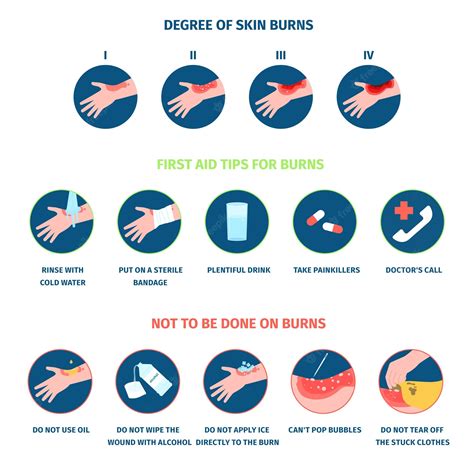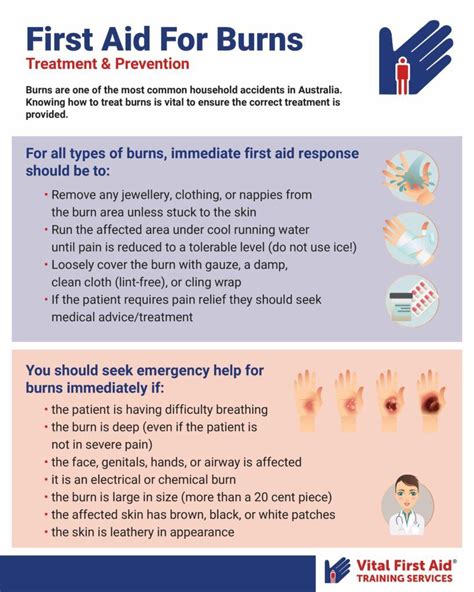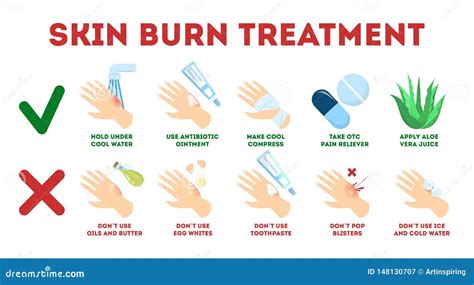Intro
Burns are a common type of injury that can occur in the home, and while they can be painful and potentially serious, many can be effectively treated with proper burn care at home. In fact, according to the American Burn Association, the majority of burns that occur in the home are minor and can be treated with basic first aid. However, it's essential to know how to properly care for burns to promote healing, prevent infection, and minimize scarring. In this article, we'll explore the importance of burn care at home, the different types of burns, and provide a comprehensive guide on how to treat burns effectively.
Burns can be caused by a variety of factors, including heat, cold, electricity, chemicals, and radiation. The most common types of burns are thermal burns, which are caused by heat from fires, scalds, or contact with hot surfaces. According to the Centers for Disease Control and Prevention (CDC), thermal burns account for approximately 80% of all burn injuries. Other types of burns, such as electrical burns, chemical burns, and radiation burns, are less common but can be more severe and require specialized treatment.
Proper burn care at home is crucial to prevent infection, promote healing, and minimize scarring. Infection is a significant risk with burns, as the damaged skin can provide a conduit for bacteria to enter the body. If left untreated, infections can lead to serious complications, including sepsis, organ failure, and even death. Moreover, burn scars can be permanent and disfiguring, affecting not only the physical appearance but also the emotional well-being of the individual.
Understanding Burn Types and Severity

Burns are classified into three main categories: first-degree, second-degree, and third-degree burns. First-degree burns, also known as superficial burns, affect only the outermost layer of skin and are characterized by redness, swelling, and pain. Second-degree burns, also known as partial-thickness burns, extend into the dermis, the layer of skin beneath the epidermis, and can cause blistering, redness, and swelling. Third-degree burns, also known as full-thickness burns, extend through all layers of skin and can cause charred or white skin, numbness, and a lack of sensation.
First-Degree Burns
First-degree burns are the most common type of burn and are typically caused by minor scalds or contact with hot surfaces. They can be treated with basic first aid, including cooling the burn with cool water, applying a topical antibiotic ointment, and covering the burn with a non-stick dressing.Second-Degree Burns
Second-degree burns are more severe than first-degree burns and can be caused by more extensive scalds or contact with hotter surfaces. They require more extensive treatment, including cooling the burn, applying a topical antibiotic ointment, and covering the burn with a non-stick dressing. In some cases, second-degree burns may require medical attention, especially if they cover a large area of the body or are deep.Third-Degree Burns
Third-degree burns are the most severe type of burn and can be life-threatening. They require immediate medical attention, as they can cause significant damage to skin, muscle, and other tissues. Third-degree burns can be caused by severe scalds, electrical burns, or contact with extremely hot surfaces.Burn Care at Home: A Step-by-Step Guide

Burn care at home involves several steps, including cooling the burn, cleaning the burn, applying a topical antibiotic ointment, and covering the burn with a non-stick dressing. Here's a step-by-step guide on how to treat burns at home:
- Cool the burn: Cool the burn with cool water for 10-15 minutes to reduce the temperature of the skin and alleviate pain.
- Clean the burn: Gently clean the burn with mild soap and water to remove any debris or bacteria.
- Apply a topical antibiotic ointment: Apply a topical antibiotic ointment to the burn to prevent infection.
- Cover the burn: Cover the burn with a non-stick dressing to protect the wound and promote healing.
- Monitor for infection: Monitor the burn for signs of infection, including redness, swelling, increased pain, and pus.
Additional Tips for Burn Care at Home
In addition to the step-by-step guide, here are some additional tips for burn care at home:- Avoid breaking blisters, as this can lead to infection and scarring.
- Avoid applying ice or ice water to the burn, as this can cause further damage to the skin.
- Avoid using harsh soap or other cleansers, as these can irritate the skin and slow healing.
- Avoid using topical creams or ointments that contain harsh chemicals or dyes, as these can irritate the skin and slow healing.
Preventing Burns at Home

Preventing burns at home is essential to reducing the risk of injury and promoting safety. Here are some tips for preventing burns at home:
- Install smoke alarms: Install smoke alarms in your home to alert you to potential fires.
- Keep flammable materials away from heat sources: Keep flammable materials, such as curtains, towels, and clothing, away from heat sources, such as stoves, ovens, and space heaters.
- Use protective gear: Use protective gear, such as oven mitts and pot holders, when handling hot objects.
- Supervise children: Supervise children when they are playing with fire or using heat sources, such as stoves or ovens.
- Keep electrical appliances away from water: Keep electrical appliances, such as hair dryers and radios, away from water to prevent electrical burns.
Additional Tips for Preventing Burns at Home
In addition to the tips above, here are some additional tips for preventing burns at home:- Use a thermometer: Use a thermometer to check the temperature of water and other liquids to prevent scalds.
- Keep hot surfaces clean: Keep hot surfaces, such as stoves and ovens, clean to prevent grease and food from accumulating and causing fires.
- Use a fire extinguisher: Use a fire extinguisher to put out small fires before they spread.
Seeking Medical Attention for Burns

While many burns can be treated at home, some require medical attention. Here are some signs that you should seek medical attention for a burn:
- The burn is large or deep: If the burn covers a large area of the body or is deep, you should seek medical attention.
- The burn is on the face, hands, or feet: If the burn is on the face, hands, or feet, you should seek medical attention, as these areas are sensitive and require specialized treatment.
- The burn is caused by electricity or chemicals: If the burn is caused by electricity or chemicals, you should seek medical attention, as these types of burns can be more severe and require specialized treatment.
- You have a fever or other signs of infection: If you have a fever or other signs of infection, such as redness, swelling, or increased pain, you should seek medical attention.
What to Expect at the Doctor's Office
If you need to seek medical attention for a burn, here's what you can expect at the doctor's office:- A thorough examination: The doctor will examine the burn to determine its severity and extent.
- Cleaning and dressing the burn: The doctor will clean and dress the burn to promote healing and prevent infection.
- Prescription medication: The doctor may prescribe medication to manage pain, prevent infection, and promote healing.
- Follow-up care: The doctor will provide follow-up care to monitor the burn's progress and adjust treatment as needed.
What are the most common causes of burns at home?
+The most common causes of burns at home are scalds from hot liquids, contact with hot surfaces, and electrical burns from appliances.
How can I prevent burns at home?
+You can prevent burns at home by installing smoke alarms, keeping flammable materials away from heat sources, using protective gear, supervising children, and keeping electrical appliances away from water.
What are the signs of infection in a burn?
+The signs of infection in a burn include redness, swelling, increased pain, pus, and a foul odor.
When should I seek medical attention for a burn?
+You should seek medical attention for a burn if it is large or deep, if it is on the face, hands, or feet, if it is caused by electricity or chemicals, or if you have a fever or other signs of infection.
How can I promote healing and prevent scarring in a burn?
+You can promote healing and prevent scarring in a burn by keeping the burn clean and dry, applying topical antibiotic ointment, covering the burn with a non-stick dressing, and avoiding picking at scabs or scratching the burn.
We hope this comprehensive guide to burn care at home has provided you with the information and resources you need to prevent and treat burns effectively. Remember to always prioritize safety and take precautions to prevent burns from occurring in the first place. If you have any further questions or concerns, don't hesitate to reach out to a medical professional for advice. Share this article with your friends and family to help spread awareness about burn prevention and treatment, and let's work together to create a safer and healthier community for everyone.
